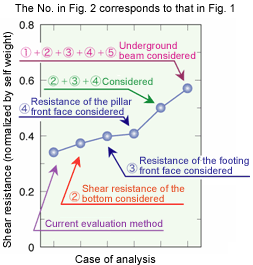| 2. A method of evaluating the earthquake resistance of existing foundation structures in consideration of interaction with the surrounding ground | |||||
| |||||
|
When structures undergo earthquake vibration, they are subjected to various resisting forces from the surrounding ground through interaction (Fig. 1). Because of insufficient data on earthquake damage and constraints in analytical technology, no methods have yet been established to evaluate resisting forces 2. to 5. in Fig. 1. As a result, these forces have generally been neglected in safety considerations, and foundations have therefore often been judged to require reinforcement against large-scale earthquakes. Consequently, the RTRI has proposed a technique to evaluate in detail the interaction between foundations and the surrounding ground, aiming to determine the earthquake resistance of existing foundations more precisely than by conventional methods.
HOME > Major Results of Research and Development in Fiscal 2004 > I Safety/Reliability RTRI HOME Copyright(c) 2005 Railway Technical Research Institute,Tokyo Japan, All rights reserved. |

